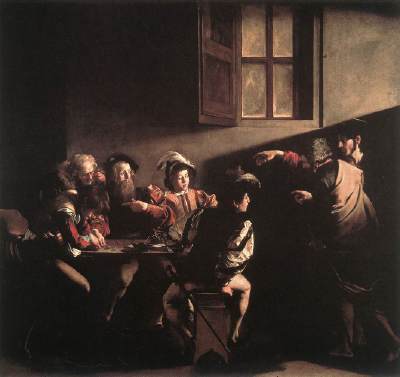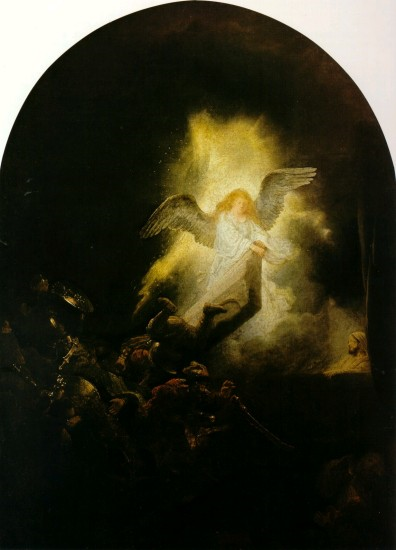Abstract
Baroque period is distinguished by the depiction of space and movement where expression was of great importance. Exaggeration and luxury are the major distinctions of that period that were revealed in painting as well. However, the Italian Painting of the early period illustrated the religious theme where an emotional atmosphere but not luxury takes place. Caravaggio with his The Calling of Saint Matthew, Carracci with The Flight into Egypt, Rembrandt with The Resurrection of Christ is the most prominent painting that reveals the religious topics of the Baroque stream.
Caravaggio, The Calling of Saint Matthew, 1599-1600

The work is painted by an outstanding Italian painter Caravaggio and is hung in the Contarelli Chapel, the French Church in Rome. The painting portrays Saint Mathew inside the building with the Christ outside calling for him through the window. In the picture, the artist depicted gamblers and moneylenders sitting around the table. Levi, who is later called Apostle Matthew, sits at a table together with his assistants counting the day’s revenues. The group is lighted from the window, on the upper right side of the painting. Caravaggio depicted Christ with his upraised hand in the beam of light as if summoning Mathew. The gesture made by Christ is rather laconic but it is enough to foresee the future development in the picture. In its turn, the gesture made by Matthew is also rather narrative and expressive and means that he is the one who is being called by Christ. The expression on his face discloses reconciliation and obedience. Other figures on the canvas are so reluctant to notice Christ so their ignorance symbolizes their refusal to follow God and to enter the path of eternal life. They are too obsessed with the daily routine so they do not have much time for a confession. The scene reveals the climax of the story marked by the reaction of Christ’s summoning.
The structure of the picture points out the gap between the mortal and divine creatures. The division also stipulates the difference between earth life and eternal life. The artist’s The Calling of Matthew is a diligent work of art of the Baroque period since the painting reflects the emotional charge of the picture. In addition, asymmetric structure and the absence of order are also typical of this time thus reflecting the fight between the divine forces and human indifference.
The Flight into Egypt by Annibale Carracci, 1603

Annibale Carracci is an Italian artist that studied at an academy of art established by his family members. Carracci learned that art should be taught from the point of philosophy of art. Hence, his works embodied the traditions of the Renaissance along with life drawing.
Like Caravaggio’s work, The Flight into Egypt is also the narration based on the biblical topic where the artist created the classic landscape as the background for the actions of the figures. The story is about the advent of Joseph and his wife with God’s child to Egypt (Matthew 2:13-14). In the picture, nature is subjected the divine laws and human rational thinking. Thus, calm hills and fields, as well as regular trees and light sky, emphasize the spirit of Renaissance, on the one hand, the presence of the Baroque motives. The contrast between the light and the shadow suggests the expressive and emotionally charged atmosphere in the picture. The ideal life is also uncovered through the rightness of the buildings that are opposed to the irregular and asymmetric landscape. The pastoral nature that contrasts the ideal antique architecture can be assessed as the artist’s protest against the balance between the nature and human world. Here, tombs and temples are captured in the chaos and the disorder of natural elements (Kleiner, 2008).
In conclusion, the work by Carracci is the embodiment of seventeenth-century painting. The plot of the work is revealed through the skillful depiction of the landscape that is alive and inserts a deep sense in the picture. Additionally, the picture shows a constant contradiction between the emotion presented by nature and the reason presented by the artificial building of the ideal forms.
Resurrection of Christ, Rembrandt van Rijn, 1635-1639

The resurrection of Christ is a painting that is also devoted to religious themes. Rembrandt tried to reveal the resurrection as an important biblical event by contrasting light and shadow that prevails in the picture. Like in the previous pictures, the light symbolizes the divine powers, the powers of good.
While depicting Christ, Rembrandt is concerned with rendering the expression and the gestures of the figure thus revealing the scene of action and constant movement. The artist planned to convey the movement so that the viewer could perceive the previous events and foresee the future development. Rembrandt managed to dramatize the event by playing with the colors where there are no smoothing transfers from the shadow to the light. Though the painting has some Renaissance motives as well, the expression and motion are the bright evidence of the Baroque spirit. Additionally, there is always the culmination of the events that could be kept in mind. The character is directly connected with other objects in the picture. At the same time, the gap between the human and Christ is obvious. In this respect, people depicted in the lower-left symbolize inferiority and mortality, and Christ captured by the divine light is the embodiment of eternal life. Again, the rise of light could be identified with the confrontation of life and death, good and evil (Bockenmuhl 2000).
The resurrection of Christ is the resurrection of life out from death and chaos. The fact the painting is structured asymmetrically is quite typical of the Baroque stream especially in the depiction of the religious motive since it is always a confrontation. The analyzed painting of the Baroque period presents both the emotional filling and the meaningful usage of the colors.
Reference
Bockenmuhl, M. (2000). Rembrandt, 1606-1669: the mystery of the revealed form. Germany: Taschen.
Carracci, A. The Flight into Egypt. Web Gallery of Art. 2009. Web.
Caravaggio, The Calling of Saint Matthew. Web Gallery of Art. 2009. Web.
Kleiner, F. (2008). Gardner Art Through the Ages: A Global History. US: Cengage Learning EMEA.